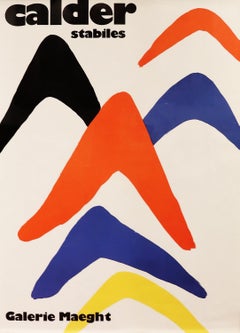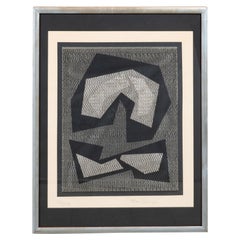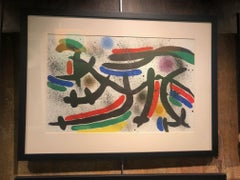(after) Alexander Calder More Art
American, b. 1898
Combining abstract surrealism and biomorphic imagery into a distinctive style, Calder has become one of the 20th Century’s most iconic and important artists. Besides sculptures, Calder was also prolific in other art forms. He produced jewelry, tapestry and stage designs, as well as drawings, oil paintings, water colors, etchings, lithographs and serigraphs. Born in Philadelphia in 1898
Alexander Calder (1898 – 1976) was a monumental artist. He invented the mobile, and airy, hanging structure connected by wires that are set in motion by the wind. These mobiles tremendously influenced the art world. Calder’s versions celebrated form and color, with simplicity and profundity. As a trained engineer, began to practice as a freelance artist after attending New York’s Art Students League. Calder was strongly inspired circus spectacle, and thus constructed entertaining mobiles often accompanied by music. Producing dynamic yet playful mobile sculptures, Calder dismissed the formal structures of art and redefined its infinite possibilities.1
Overall Width
to
Overall Height
to
1
1
1
28
346
232
206
157
1
Artist: (after) Alexander Calder
Calder Stabiles
By (after) Alexander Calder
Located in Missouri, MO
Calder Stabiles
Galerie Maeght Fine Art Poster Print
30 x 22 inches
31 x 23 inches with frame
Alexander Calder (American, 1898-1976)
One of America's ...
Category
20th Century Surrealist (after) Alexander Calder More Art
Materials
Color
Related Items
Untitled #1, 1964 from New York Ten
By Mon Levinson
Located in New York, NY
This dynamic work was realized by the esteemed 20th Century modern artist Mon Levinson in 1964. The work was realized in 1964, and printed in 1965 by Chiron Press in New York- the same year that Levinson was included in the seminal Op-Art exhibition "The Responsive Eye", alongside contemporary luminaries such as Bridget Riley. An identical work from this edition resides in the permanent collection of the New York MoMA. This mixed media work consists of an translucent vinyl sheet layered over a print- part etching, part lithograph. The clear vinyl sheet is embossed with a tight pattern of sinuously curved repeating black lines and is subtly raised in places- creating a subtle three dimensionality and dynamic sense of movement. The paper is inscribed with the same recurring pattern of snaking black lines, like a fine filigree, with two weighty black geometric forms that appear to crowd the composition. Smaller geometric forms reside within creating the apparition of negative space in the bone hued paper. The juxtaposition of the delicate texture and colossal feeling forms imbues the piece with a stunning dynamism and tension, helping to explain why Levinson is among the most influential and important artist to come out of the Op Art movement. His work is in the permanent collections of important institutions around the world including the Museum of Modern Art as well as the Whitney Museum of American Art in New York. Signed by the artist and marked 18/200. The work comes presented in a custom walnut and white gilt frame...
Category
1960s Op Art (after) Alexander Calder More Art
Materials
Mixed Media
Twentieth Century Untitled Abstract Limited Edition Stone Lithograph Joan Miro
By Joan Miró
Located in ludlow, GB
Twentieth Century Untitled Abstract Limited Edition Stone Lithograph by Joan Miro.
Originally in a catalogue and consequently there is slight evidence of a fold in the centre. We h...
Category
20th Century Abstract (after) Alexander Calder More Art
Materials
Lithograph
Twentieth Century Untitled Abstract Limited Edition Stone Lithograph Joan Miro
By Joan Miró
Located in ludlow, GB
Twentieth Century Untitled Abstract Limited Edition Stone Lithograph by Joan Miro.
This is a limited edition lithograph that is untitled. It was originally in a catalogue and consequ...
Category
20th Century Abstract (after) Alexander Calder More Art
Materials
Lithograph
Centennial Medal for the Metropolitan Museum of Art
By Frank Stella
Located in New York, NY
Frank Stella
Centennial Medal for the Metropolitan Museum of Art, 1970
17 Color enamel on rhodium plated bronze plaque (incised signature an...
Category
1970s Abstract (after) Alexander Calder More Art
Materials
Metal, Enamel
Monograph: Francis Bacon (hand signed and warmly inscribed by Francis Bacon)
By Francis Bacon
Located in New York, NY
Francis Bacon
Francis Bacon (hand signed and warmly inscribed by Francis Bacon), 1975
Softcover catalogue with stiff wraps (hand signed and warmly inscribed by Francis Bacon)
hand si...
Category
1970s Surrealist (after) Alexander Calder More Art
Materials
Paper, Ink, Mixed Media, Lithograph, Offset, Felt Pen
H 8.5 in W 10.75 in D 0.5 in
Limited Edition monograph with slipcase: George Condo at Cycladic (hand signed)
By George Condo
Located in New York, NY
George Condo at Cycladic (hand signed by George Condo), 2018
Limited Edition monograph with slipcase (hand signed by George Condo)
11 × 8 1/2 inches
Published in a stated limited edi...
Category
2010s Contemporary (after) Alexander Calder More Art
Materials
Paper, Ink, Mixed Media, Lithograph, Offset, Board
Twentieth Century Untitled Abstract Limited Edition Stone Lithograph Joan Miro
By Joan Miró
Located in ludlow, GB
Twentieth Century Untitled Abstract Limited Edition Stone Lithograph by Joan Miro.
This is a limited edition lithograph that is untitled. It was originally in a catalogue and consequ...
Category
20th Century Abstract (after) Alexander Calder More Art
Materials
Lithograph
Icarus (from the Mythology portfolio)
By Salvador Dalí
Located in New York, NY
Signed by the artist in pencil, and also dated in pencil in lower right corner. Numbered 108/150 in lower left corner. Published by Argillet, Paris. From Le Mythologie.
Category
1960s Surrealist (after) Alexander Calder More Art
Materials
Drypoint, Etching, Color
First edition hardback monograph (hand signed and inscribed by Hirst with heart)
By Damien Hirst
Located in New York, NY
Damien Hirst
"I want to spend the rest of my life everywhere with everyone," 1997
Hardback monograph with hand signed ink inscription
Fine provenance:
Hand signed and inscribed to a...
Category
1990s Pop Art (after) Alexander Calder More Art
Materials
Ink, Mixed Media, Lithograph, Offset
Untitled I (Abstract in Blue, Green and Purple) by Victor Pasmore, 1988
By Victor Pasmore
Located in Kingsclere, GB
Untitled I (Abstract in Blue, Green and Purple) by Victor Pasmore, 1988
Additional information:
Medium: screenprint
57 x 84 cm
22 1/2 x 33 1/8 in
signed, dated and numbered in penci...
Category
20th Century (after) Alexander Calder More Art
Materials
Screen
The Face in the Windmill
By Salvador Dalí
Located in New York, NY
Color Lithograph. Artist's proof, aside from an edition of 150. Signed and inscribed "EA" in lower right and left corner respectively. Published by Sidney Z. Lucas, New York.
C...
Category
1960s Surrealist (after) Alexander Calder More Art
Materials
Lithograph, Color
Cajas-I
By Ricardo Mazal
Located in Los Angeles, CA
This unframed, signed, limited edition pigment print by world renown artist Ricardo Mazal exists in an edition of 50. The paper size is 37 inches h x 35 inches w and an image size of...
Category
2010s Abstract (after) Alexander Calder More Art
Materials
Archival Paper, Archival Pigment
(after) Alexander Calder more art for sale on 1stDibs.
Find a wide variety of authentic (after) Alexander Calder more art available for sale on 1stDibs. Much of the original work by this artist or collective was created during the 20th century and is mostly associated with the Surrealist style. Not every interior allows for large (after) Alexander Calder more art, so small editions measuring 22 inches across are available.
Questions About (after) Alexander Calder More Art
- 1stDibs ExpertOctober 12, 2021The American sculptor Alexander Calder is known as the father of the mobile, a moving artwork composed of delicately balanced sculptural forms suspended from the ceiling. On 1stDibs, find a variety of vintage Alexander Calder drawings and other sculptures.
- 1stDibs ExpertOctober 15, 2024Most artists consider Alexander Calder to be a Kinetic artist rather than a Surrealist. The American sculptor is known as the father of the mobile, a moving artwork composed of delicately balanced sculptural forms usually suspended from the ceiling. Calder also pioneered a new art form with wire sculptures, which he described as “drawings in space.” Like his famous mobiles, the wire sculptures were suspended so that they turned with any air movement, presenting different forms when viewed from different angles. Explore a diverse assortment of Alexander Calder art on 1stDibs.
- 1stDibs ExpertAugust 15, 2024Alexander Calder was famous for his work as an artist. The American sculptor is known as the father of the mobile, a moving artwork composed of delicately balanced sculptural forms suspended from the ceiling. He also created large-scale sculptures that frequently involved kinetic elements. Some of his best-known works include Mobile (Arc of Petals), Cirque Calder, Josephine Baker (III), Fish and A Universe. On 1stDibs, explore a selection of Alexander Calder art.
- Where is Alexander Calder’s art?1 Answer1stDibs ExpertApril 5, 2022Alexander Calder’s artwork has found its home in many museums and art galleries around the world, including the Museum of Modern Art and the Guggenheim Museum. Shop a selection of Alexander Calder’s pieces from some of the world’s top art dealers on 1stDibs.
- 1stDibs ExpertApril 5, 2022The American sculptor Alexander Calder invented the mobile, a moving artwork composed of delicately balanced sculptural forms suspended from the ceiling. His mobiles were an innovative feat and initially used motors for movement, which he later abandoned for air currents alone. Calder was also a pioneer of wire sculptures. Shop a selection of Alexander Calder pieces from some of the world’s top art dealers on 1stDibs.
- 1stDibs ExpertMarch 22, 2022Alexander Calder is best known for his sculptures. He produced large, playful freestanding and hanging works in vibrant colors. Examples include Mobile-Stabile, Lobster Trap and Fish Tail and Flying Dragon. On 1stDibs, you can shop a selection of Alexander Calder art.
- 1stDibs ExpertMay 3, 2024Alexander Calder mostly made sculptures, although he also worked in printmaking, painting, performance and other media. He is known as the father of the mobile, a moving artwork composed of delicately balanced sculptural forms suspended from the ceiling. Some of his most famous works include Cirque Calder, A Universe, Josephine Baker (III), Mobile (Arc of Petals), Devil Fish, Romulus and Remus and Fish. On 1stDibs, find a variety of Alexander Calder art.
- 1stDibs ExpertApril 5, 2022American artist Alexander Calder is best known for his work in sculpture, particularly his monumental sculptures and innovative ‘mobiles’ in the tradition of kinetic art. Shop a collection of authentic Alexander Calder pieces from some of the world’s top art dealers on 1stDibs.
- 1stDibs ExpertApril 5, 2022Alexander Calder's mobiles were revolutionary because he largely pioneered the art form of creating hanging sculptures that were able to move freely in response to airflow. Calder was a prolific artist believed to have produced more than 22,000 works during his life. Shop a variety of Alexander Calder art on 1stDibs.
- 1stDibs ExpertApril 5, 2022There are several interpretations of how to describe the characteristics of Alexander Calder’s sculptures. Some say they are abstract, with life-like elements, others say they are flat, simplified shapes that intersect at opposing angles. See the magic for yourself — shop a selection of Alexander Calder pieces from some of the world’s top art dealers on 1stDibs.
- 1stDibs ExpertApril 5, 2022The term ‘mobile’, which was coined by Marcel Duchamp, was used to describe Alexander Calder’s work, as Calder’s sculptures often moved with the help of motors or wind. ‘Mobiles’ was a French pun which meant ‘motion’. On 1stDibs, find a variety of original artwork from Alexander Calder.
- 1stDibs ExpertApril 3, 2024Alexander Calder invented the mobile, a moving artwork composed of delicately balanced sculptural forms suspended from the ceiling. The revered American sculptor's mobiles were an innovative feat and initially used motors for movement, which he later abandoned for air currents alone. Calder was also a pioneer of wire sculptures. (He was a celebrated modernist printmaker, too, and while jewelry was a secondary métier for him, interest in his wearable art has accelerated in recent years.)
For Calder, the fascinating moment of artistic alchemy comes sometime between his representational canvases of the late 1920s and 1931, the year of his first show of abstract sculpture. Moving to Paris helped spur his creativity, as it did for so many artists and writers. The moment Calder arrived, he began working on one of his most seminal pieces, Cirque Calder (1931), his delightful distillation of the circus into what are essentially three-dimensional line drawings made with wire.
Shop authentic Alexander Calder prints, sculptures and other art from some of the world’s top art dealers on 1stDibs. - 1stDibs ExpertMay 3, 2024The art movement that Alexander Calder was connected to was kinetic art. The term refers to art that moves or has the appearance of movement. With their ability to sway and turn once suspended, Calder's mobiles are often referenced as examples of kinetic art. On 1stDibs, find a selection of Alexander Calder art.
- 1stDibs ExpertApril 16, 2024Alexander Calder used many of the elements of art when producing his works. The American sculptor is known as the father of the mobile, a moving artwork composed of delicately balanced sculptural forms suspended from the ceiling. These kinetic pieces use color, shape and space to convey a sense of unity, and the form of the art allows it to interact with its environment. Find a variety of Alexander Calder art on 1stDibs.
- 1stDibs ExpertOctober 24, 2024How much an Alexander Calder mobile is worth depends on its historical significance, size, condition and other factors. In 2012, his 1945 piece Lily of Force sold for $18.5 million at auction in New York City. The American sculptor is known as the father of the mobile, a moving artwork composed of delicately balanced sculptural forms suspended from the ceiling. Always interested in putting forms in motion, Calder also pioneered a new art form called “wire sculptures,” which he described as “drawings in space.” Like his famous mobiles, the wire sculptures were suspended so that they turned with any movement of the air, presenting different forms when viewed from different angles. If you're in possession of a Calder mobile, a certified appraiser or knowledgeable art dealer can help you determine how much it may be worth. On 1stDibs, explore a range of Alexander Calder art.
- 1stDibs ExpertApril 5, 2022Like all meaningful works of art, the mood that best describes American artist Alexander Calder’s sculptures is subject to interpretation. Common descriptors for his abstract work include “playful” or “whimsical.” Calder is best known as the father of the mobile, a moving artwork composed of delicately balanced sculptural forms suspended from the ceiling. Shop a selection of Alexander Calder pieces from some of the world’s top art dealers on 1stDibs.
- 1stDibs ExpertMarch 13, 2024Alexander Calder produced more than 22,000 works of art during his lifetime. The prolific artist made paintings, drawings, prints, tapestries, stage sets, jewelry and other types of art. Some of his most famous pieces include Cirque Calder, Josephine Baker (III), A Universe, Mobile (Arc of Petals) and Devil Fish. Shop a diverse assortment of Alexander Calder art on 1stDibs.
- What is a Calder mobile?1 Answer1stDibs ExpertNovember 2, 2021A “Calder mobile” refers to a moving artwork created by American sculptor Alexander Calder composed of delicately balanced sculptural forms suspended from the ceiling. Calder worked a number of jobs, including as a hydraulic engineer and draftsman for the New York Edison Company, before deciding to pursue an artistic career. He never abandoned his engineering background, however, applying his understanding of gears and moving parts in all his artworks, from mechanical toys like the Cirque Calder (1931) and his revered prints to his free-standing abstract sculptures, called stabiles. Find a collection of original Alexander Calder art on 1stDibs.
- How did Calder become an artist?1 Answer1stDibs ExpertMarch 13, 2024The story of how Calder became an artist begins with his parents. Both artists themselves, they did not want him to suffer the hardships of trying to make a living in art, so they encouraged the young Alexander Calder to study mechanical engineering at the Stevens Institute of Technology in Hoboken, New Jersey. He subsequently worked a number of jobs, including as a hydraulic engineer and draftsman for the New York Edison Company, before deciding to pursue an artistic career. He applied his engineering background to his artwork, such as his understanding of gears and moving parts for kinetic sculptures like Cirque Calder (1931) and free-standing abstract sculptures he called “stabiles.” Explore a selection of Alexander Calder art on 1stDibs.
- What is Alexander McQueen?1 Answer1stDibs ExpertMarch 22, 2022Alexander McQueen is a luxury fashion brand founded by a designer by the same name. The fashion house designs haute couture and prêt-à-porter clothing for men and women, as well as shoes, handbags, accessories and jewelry. Shop a large selection of Alexander McQueen on 1stDibs.


